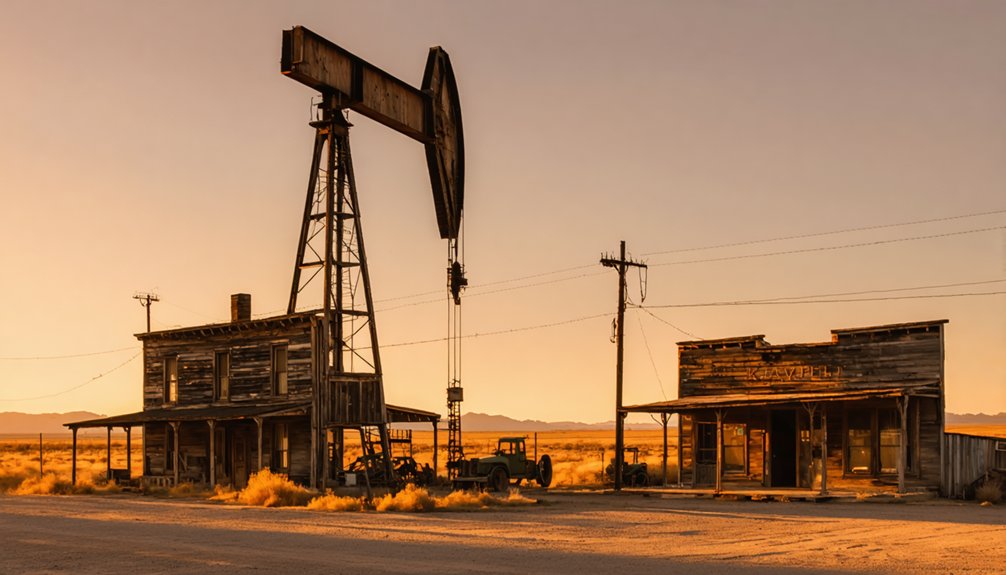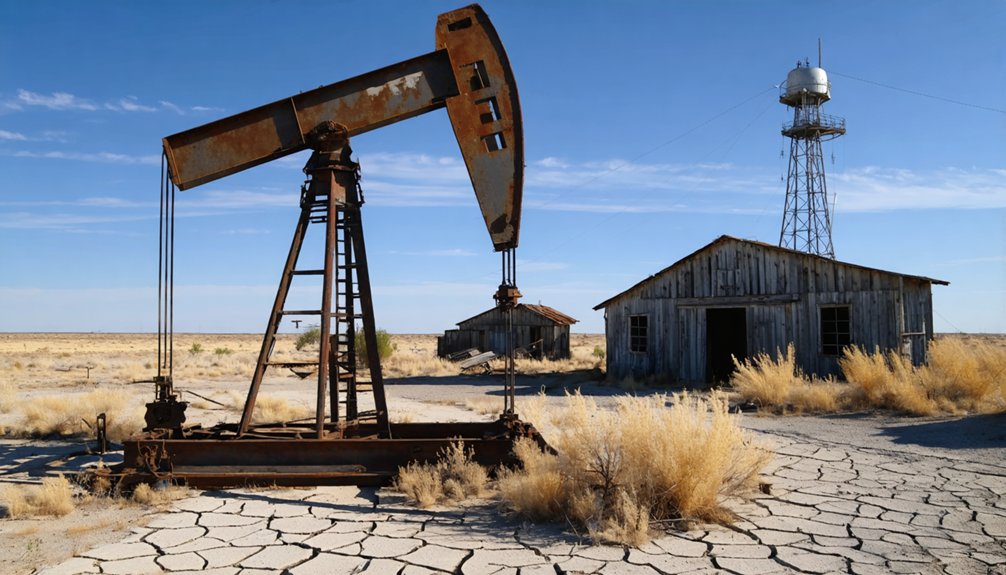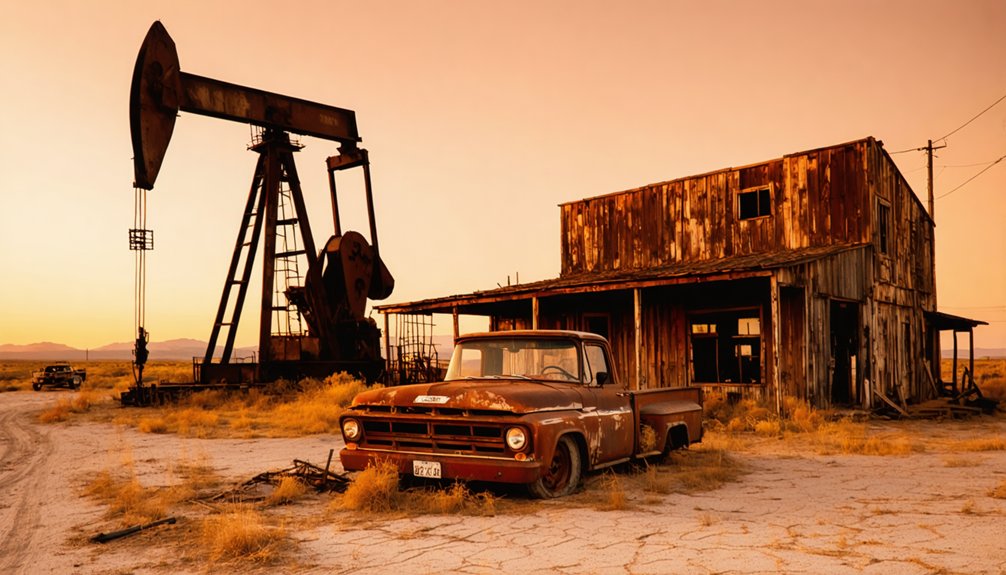You’ll find Fasken’s ruins along FM 1788 in Andrews County, Texas, where David Fasken’s 1917 vision for a thriving agricultural community once stood on his 227,000-acre “C” Ranch. The town featured a railroad depot, hotel, general store, and schoolhouse, serving ranch workers and railroad personnel. After the final train departed in 1925, water scarcity and environmental challenges transformed this frontier settlement into a ghost town, though its foundations still whisper stories of Texas’s ambitious past.
Key Takeaways
- Fasken was founded in 1917 when David Fasken purchased 227,000 acres to establish an agricultural community with amenities and railroad connections.
- The town’s infrastructure included a railroad depot, hotel, general store, small zoo, and one-room schoolhouse serving ranch workers and railroad personnel.
- Economic decline began after 1925 when the railroad ceased operations, leading to mass exodus and eventual abandonment of the settlement.
- Water scarcity, environmental challenges, and infrastructure damage from floods contributed significantly to Fasken’s transformation into a ghost town.
- Today, only foundational ruins remain along FM 1788 in Andrews County, Texas, though the Fasken family maintains influence through oil operations.
The Rise of a Frontier Settlement
When David Fasken purchased the sprawling 227,000-acre “C” Ranch in 1917, he envisioned transforming the desolate West Texas terrain into a thriving agricultural community.
Through his Midland Farms Company, he launched an ambitious plan to subdivide the vast ranch into smaller farms, fueled by settler aspirations of carving out their own piece of Texas.
You’d have found impressive amenities designed to attract pioneering families to this east central Andrews County location.
The community vision included a railroad depot, hotel, general store, and even a small zoo.
The Midland and Northwestern Railway would connect settlers to larger markets, while a one-room schoolhouse served the educational needs of frontier families.
Everything seemed positioned for success, with the infrastructure ready to support a new wave of agricultural development.
Like the law firm that would later bear the name Fasken & Calvin in 1863, David Fasken’s ambitions reflected a pioneering spirit focused on growth and development.
However, the railway faced significant challenges and entered receivership by 1920, dealing a major blow to the settlement’s transportation infrastructure.
Railroad Dreams and Development
At the heart of Fasken’s ambitious development plan stood the Midland and Northwestern Railway, chartered on January 16, 1916, by Fasken’s Midland Farms Company. This railroad innovation connected Fasken to the Texas and Pacific Railway in Midland, creating essential transportation links for cattle, agricultural products, and settlers.
You’d find community building in action as the railroad fostered Fasken’s growth, with the town soon boasting a depot, hotel, general store, and schoolhouse. Located in Andrews County, this incorporated town developed into a bustling hub for the region.
The borrowed engine from Texas and Pacific Railway made schedules unpredictable, and crews had to stop frequently to open wire gates along the route. During their travels, they’d even shoot coyotes to protect livestock. The railway completed 65 miles of track connecting Midland to Seminole in 1918.
Teacher Lois Patterson’s weekly train commute to the one-room schoolhouse symbolized the railroad’s role in binding the community together.
Life in Early Fasken

Life in early Fasken centered around a modest frontier settlement established in 1917 by the Midland Farms Company.
You’d find a small but determined community of ranch workers and railroad personnel living in simple wooden houses, gathering at the local hotel and general store for community gatherings.
Your daily routines would’ve revolved around ranch work, cattle drives, and railroad schedules.
If you’d children, they’d attend the one-room schoolhouse where dedicated teachers like Lois Patterson traveled by train from Midland each week.
You’d witness railroad crews stopping to shoot coyotes, and you’d need to navigate the wire gates that crossed the tracks.
The town’s economy thrived on cattle ranching, with stock pens facilitating livestock shipments to larger markets via the Midland and Northwestern Railroad.
Like many Texas frontier towns that became barren sites, Fasken eventually succumbed to economic decline.
The settlement was part of a vast 222,600 acre property originally sold to Nelson Morris before being acquired by the Fasken family.
Environmental Struggles and Economic Hardships
Despite initial prosperity from ranching and rail operations, Fasken faced mounting environmental challenges that would ultimately contribute to its decline.
Water scarcity became a significant issue as the Ogallala Aquifer depleted, forcing the town to rely on costly brackish water from the Santa Rosa Formation. You’d find the situation worsened during extreme droughts, particularly in 2011 when rainfall dropped to just 3 inches. The company implemented aggressive conservation efforts by using recycled drilling water to meet 41% of their total water needs.
- The town’s oil and gas operations disrupted 185 acres of essential wildlife habitat, threatening species like the Texas horned lizard.
- Environmental contamination risks increased with proposed nuclear waste facilities just 38 miles upwind.
- Flash flooding damaged crucial infrastructure, including the railroad that once brought prosperity.
These environmental pressures, combined with economic vulnerabilities, accelerated Fasken’s transformation into a ghost town.
The Final Days of a Prairie Town
You’ll find that Fasken’s fate was sealed when the final train departed in 1925, marking the end of essential transportation links that had sustained the prairie settlement.
Nature quickly began to reclaim the struggling town as floods and droughts continued their relentless assault on the remaining infrastructure and farmland.
The abandoned buildings that once housed thriving businesses, including the general store, hotel, and schoolhouse, stood as silent witnesses to the town’s shift into a certified ghost town by the early 1930s.
The town’s founder David Fasken had originally purchased 226,000 acres of Texas land with dreams of agricultural prosperity, but the harsh conditions proved unsuitable for farming.
Railroad’s Last Whistle
When heavy rains pummeled the Midland and Northwestern Railroad tracks in 1923, they delivered the final blow to an already struggling prairie lifeline.
You wouldn’t have recognized this railroad’s humble beginnings when David Fasken chartered it in 1916 to connect his vast holdings to Midland’s Texas and Pacific Railway.
The line’s rapid decline reflected deeper issues in its seven-year railroad history and community impact.
- The railroad limped along with borrowed equipment, including a secondhand engine that caused unreliable schedules.
- Crews spent countless hours opening gates and shooting coyotes to pass time during slow journeys.
- By 1920, operations had effectively ceased, leaving Fasken’s residents without essential transportation links.
The standard gauge 66-mile railroad line stretched through several towns, including Florey and Seminole.
The rain-damaged tracks were never repaired, and the town’s dreams of agricultural prosperity washed away with them.
Nature Reclaims All
As the last residents trickled away from Fasken in the early 1920s, nature began its methodical reclamation of the prairie town.
You’d find native grasses and shrubs quickly taking root in abandoned lots, while mesquite and juniper trees gradually consumed the forgotten streets.
Wildlife resurgence transformed the ghost town into a haven – coyotes and deer made homes of crumbling buildings, while native birds nested in deteriorating rooftops.
Like many towns in the region that lost over 50% of their residents, Fasken’s fate was sealed by economic hardship and agricultural decline.
Seasonal rains carved new paths through old roadbeds, and floods washed away the remaining foundations.
Without human maintenance, wooden structures succumbed to termites and weather, while abandoned farm equipment rusted into the soil.
By the 1930s, the natural reclamation was nearly complete.
What was once a bustling prairie town had seamlessly blended back into the semi-arid West Texas landscape.
Empty Buildings Stand Watch
The abandoned buildings of Fasken stood as silent sentinels marking the town’s final chapter, even as nature steadily claimed the surrounding landscape.
You’d find these forgotten structures – the depot, general store, hotel, barbershop, schoolhouse, and stock pens – standing watch over the prairie through the early 1930s.
These silent witnesses to Fasken’s decline remained intact but empty after the railroad’s demise in 1923.
Three key elements marked their abandonment:
- Heavy rains accelerated the deterioration of unused buildings
- The one-story depot and schoolhouse persisted longest against the elements
- Former centers of commerce became shells without purpose after residents departed
The buildings’ endurance, even in abandonment, symbolized both the town’s ambitious beginnings and its ultimate surrender to isolation.
Legacy and Modern-Day Remnants

Located along present-day FM 1788 in Andrews County, Texas, Fasken’s physical remnants tell the story of its dramatic rise and fall.
You’ll find foundational ruins of the depot, schoolhouse, and stock pens where a bustling town once stood. While most residential structures have vanished, the site’s historical preservation efforts keep Fasken’s memory alive through markers and local archives.
The land’s cultural impact extends beyond its ghost town status. What began as David Fasken’s 220,000-acre farming vision in 1917 transformed into the successful Fasken Oil and Ranch Company.
Though the Midland and Northwestern Railway tracks are gone, the family’s influence continues through their steadfast stewardship of the property, resisting billion-dollar offers while maintaining their century-old presence in West Texas’s energy economy.
Frequently Asked Questions
Are There Any Accessible Ruins or Structures Still Standing in Fasken Today?
Like a ghost’s whispered memory, you won’t find any accessible structures in Fasken today. Time and neglect have erased all traces of historical significance from this once-thriving settlement.
What Happened to the Zoo Animals When the Town Was Abandoned?
You won’t find clear records of the zoo animals’ fate, but they were likely released or abandoned due to limited animal welfare standards and isolation, with some possibly making a desperate escape.
How Many People Lived in Fasken During Its Peak Population?
While you’ll find no official census records, historical evidence suggests a peak population growth of only 100-200 residents around 1920, highlighting the town’s limited historical significance despite its planned development.
Did Any Original Fasken Families Continue Living in the Area Afterward?
You’ll find that only the Fasken family maintained their presence, with descendants like David Jr. and Barbara managing the area’s ranch and oil operations through family legacies spanning multiple generations.
Were There Any Notable Crimes or Lawlessness During Fasken’s Brief Existence?
You won’t find any documented crime incidents or law enforcement challenges during Fasken’s existence. Unlike wild frontier towns, this planned farming community maintained social order until environmental and economic factors caused its decline.
References
- https://en.wikipedia.org/wiki/Fasken
- https://www.wellingtonadvertiser.com/pilkingtons-fasken-brothers-were-prominent-lawyers/
- https://pboilandgasmagazine.com/the-century-mark-midland-based-fasken-oil-and-ranch-celebrates-a-momentous-milestone-in-may/
- https://www.mrt.com/business/energy/article/Fasken-Oil-and-Ranch-celebrates-100-years-7453589.php
- https://www.hmdb.org/m.asp?m=110192
- https://en.wikipedia.org/wiki/List_of_ghost_towns_in_Texas
- https://www.mrt.com/news/article/Barbara-Fasken-s-vision-lives-on-in-family-7901487.php
- https://www.legis.state.tx.us/tlodocs/86R/handouts/C3902019020614001/faf21643-d2de-4477-879c-11bbbbd83b73.PDF
- https://www.texasalmanac.com/places/fasken
- https://atlas.thc.texas.gov/Details/5003003361



